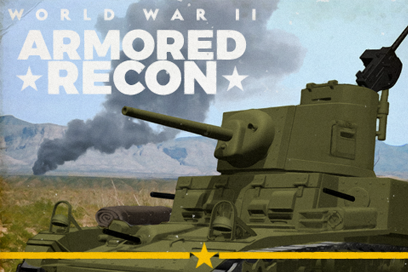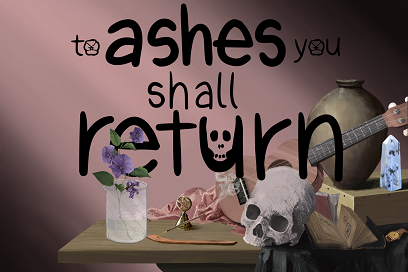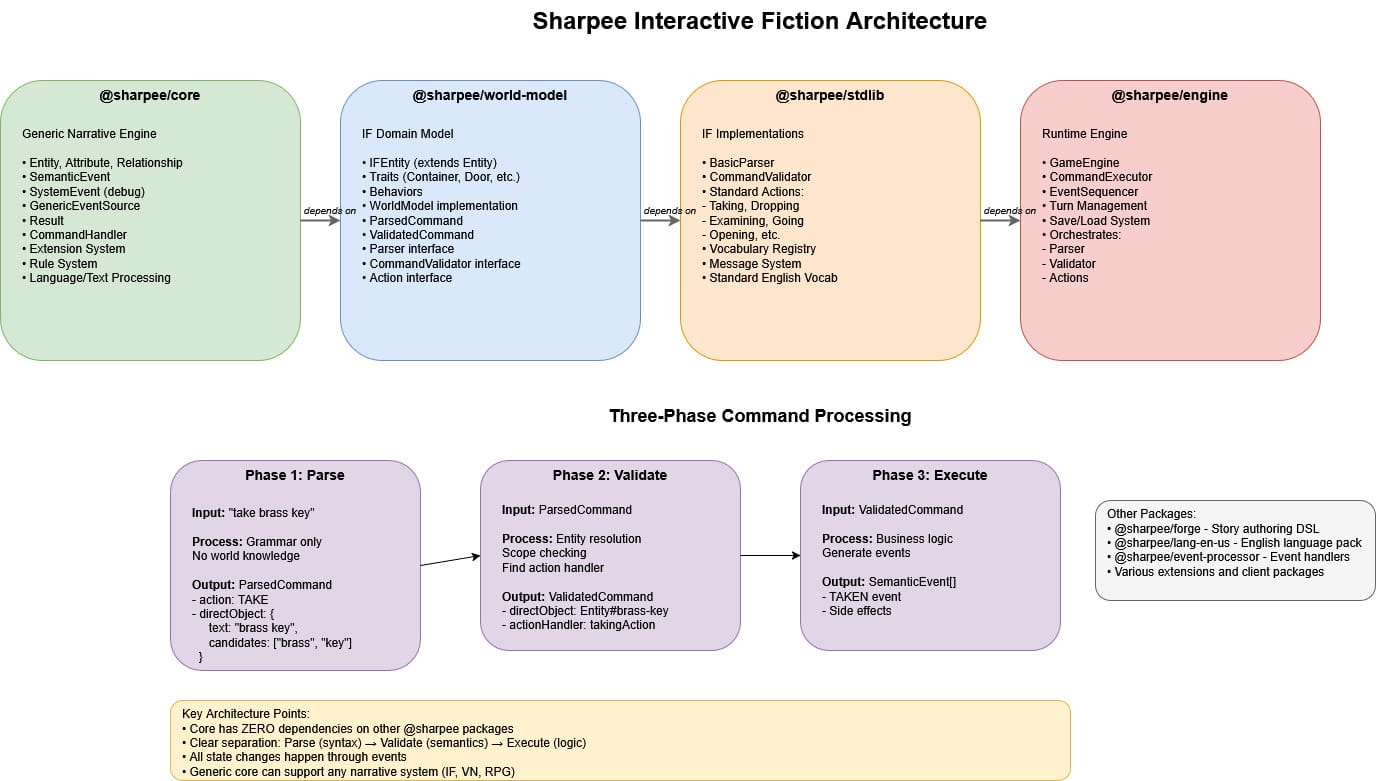This article tells part of the story of MMORPGs. It isn’t always or even usually the pioneers who reap the rewards of the trails they blaze. As often as not, some pragmatic Johnny-come-lately pops in to make off with the booty. Such was the case in the MMORPG space in the late 1990s. There Ultima […]
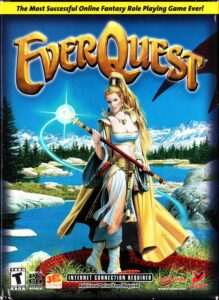
This article tells part of the story of MMORPGs.
It isn’t always or even usually the pioneers who reap the rewards of the trails they blaze. As often as not, some pragmatic Johnny-come-lately pops in to make off with the booty.
Such was the case in the MMORPG space in the late 1990s. There Ultima Online demonstrated that there was an audience for a persistent fantasy world where people could live out alternative existences together through the magic of the Internet. Yet it was another game called EverQuest that turned the proof of concept into a thriving business that enthralled hundreds of thousands of players for years on end, generating enormous amounts of money in the process. For, while the first-mover advantage should not be underestimated, there’s something to be said for being the second mover as well. EverQuest got to watch from backstage as Ultima Online flubbed line after line and stumbled over assorted pieces of scenery. Then, with a list in hand of what not to do, it was able to stride confidently onto center stage to a standing ovation. No one ever said that show business is fair.
EverQuest came to evince a markedly different personality than Ultima Online, but its origin story bears some uncanny similarities to that of the older rival it demolished. Like Ultima Online, EverQuest was born as a sort of skunk-works project within a larger company whose upper management really wasn’t all that interested in it. Like Ultima Online, EverQuest enjoyed the support of just one executive within said company, who set it in motion and then protected and nourished it like the proverbial mother hen. And like the executive behind Ultima Online, the one behind EverQuest plucked a pair of designers out of utter obscurity to help him hatch the egg.
Perhaps the most surprising aspect of the EverQuest origin story is the name of the company where it all went down: Sony Interactive Studios America. Suffice to say that, if you were to guess circa 1996 which publisher and studio would launch a market-transforming MMORPG later in the decade, Sony would not be high in your rankings. The Japanese mega-corp was flying high at the time, with a prominent footprint in most sectors of home electronics and mainstream entertainment, but it had hardly any presence at all on personal computers. The Sony PlayStation, launched in September of 1995 in North America and Europe, was on its way to becoming the most successful single games console of the twentieth century, a true mass-market cultural sensation that broadened the demographic for videogames and forever changed the way that the public perceived them. With a mainstream pile driver like that to hand, why should Sony want to waste its time with a wonky virtual world for nerds cosplaying as dwarves and mages?
It wound up doing so thanks to one man. At the beginning of 1996, John Smedley had been working for a few years as a producer at Sony Interactive, which focused almost exclusively on sports games for the PlayStation. Just 28 years old, Smedley already had a corner office with a view and a salary to match, as he and his colleagues rode the wave of the console’s incredible early success.
There was just one problem: Smedley didn’t particularly like sports, whether they happened to be played on the field or on the television screen. He had grown up as one of the kids that the jocks made fun of, the kind who walked to school every day with a Dungeons & Dragons rule book or two under his arm. It was only thanks to opportunism and happenstance that he had wound up helming projects aimed at gamers who worshiped John Madden rather than Gary Gygax. Now, he thought that the burgeoning Internet would soon make it possible to realize an old dream of 1980s nerds like him: that of playing Dungeons & Dragons online, whenever it suited you, instead of only when you could arrange to meet in person with five or so like-minded friends — assuming you even had such friends. He had a rough blueprint for how it might work, in the form of Neverwinter Nights, a game on America Online that let you effectively play one of the old single-player SSI Gold Box CRPGS over the Internet, taking a persistent character through a series of adventures with friends and strangers. It was limited in a thousand ways, but it was, so Smedley believed, the harbinger of a whole new category of game. And, after working for so long on games he really didn’t care about, he wanted to make one that he could feel passionate about.
Smedley took his idea to his boss Kelly Flock, the newly arrived head of Sony Interactive. It was a crazy thing to propose on the face of it, having absolutely nothing to do with anything the studio had ever done before nor any of the strategic priorities of the mother corporation; the PlayStation didn’t have any online capabilities whatsoever, meaning this game would have to run on personal computers. But Sony was flush with PlayStation cash and bravado, and Flock was apparently in a generous mood. He told Smedley that he could take $800,000 and hire a team to investigate the feasibility of his idea, as long as he continued to devote the majority of his time to his primary job of churning out crowd-pleasing sports games.
Those of you familiar with the tale of Ultima Online will recognize Sony Interactive standing in for Origin Systems, and John Smedley taking the role of Richard Garriott. EverQuest’s equivalent of Raph and Kristen Koster, who swept into Origin from the obscure world of textual MUDs to create Ultima Online in their image, was a pair of friends named Brad McQuaid and Steve Clover. They were programming automation and bookkeeping systems for a San Diego plant nursery during the early 1990s, working on a single-player CRPG of their own during their off hours. They called it WarWizard. Unfortunately, it was for the Commodore Amiga, a dying platform in North America. Unable to interest a publisher in a game in an unfashionable genre for a computer that was fast disappearing, they released WarWizard under the shareware model in 1993; the following year, they made an MS-DOS port available as well. By McQuaid and Clover’s own later reports, it garnered about 1500 registrations — not bad for a shareware game, but definitely not enough to let the friends quit their day job.
Undaunted, they pushed ahead with a WarWizard 2. Desperate for feedback, they uploaded a preview of the sequel to the Internet. On a lark, McQuaid appended a note: “We are releasing this demo as a business card of sorts, in order to introduce games publishers, developers, and investors to our company, MicroGenesis. If you have any question whatsoever, please contact Brad McQuaid.” This hopeful — not to say naïve — shot in the dark would change both of their lives.
For one day not long after his meeting with his boss, John Smedley stumbled across the demo, thought it was pretty impressive for the work of two guys with a day job, noticed that the two guys in question were living in Sony Interactive’s hometown of San Diego, and decided to take them up on their offer and contact them. Thus Brad McQuaid picked up his phone one rainy evening to hear a Sony producer on the other end of the line, asking him and his partner to come visit him in his slick glass-walled office downtown. It seemed too incredible to be true — but it was.
So, McQuaid and Clover, feeling uncomfortable and thoroughly out of place, were ushered by a secretary past the PlayStations in the anterooms and the NFL and MLB posters lining the walls at Sony Interactive, to see the star producer in his native habitat. What did these people want with the likes of them, two scruffy misfits hustling to make a buck peddling turn-based monster-fighting games on the shareware market? Then, as soon as the door shut behind the secretary, they felt suddenly at home. John Smedley was, they learned to their relief, one of them: a kid who had grown up playing Dungeons & Dragons in his school’s cafeteria and Ultima on his Apple II. It turned out that Smedley didn’t want them to finish WarWizard 2 for Sony Interactive; he wanted them to make something even more exciting. He explained his vision of a CRPG that you could play online, and asked them whether they’d like to help him make it. They said that they would. Smedley now learned that McQuaid and Clover were, like the Kosters over at Origin, passionate MUDders as well as semi-professional single-player CRPG developers. They knew exactly what kind of experience Smedley was envisioning, and were overflowing with ideas about how to bring it to fruition. Smedley knew right then that he’d hit pay dirt.
McQuaid and Clover were hired by Sony Interactive in March of 1996. They then proceeded to spend about six months in a windowless office far less plush than that of John Smedley, creating a design document for the game that they were already calling EverQuest; the name had felt so right as soon as it was proposed by Clover that another one was never seriously discussed. Smedley insisted that the document describe the game down to the very last detail. Here we see a marked contrast to the development process that led to Ultima Online, which came into its own gradually and iteratively, through a long string of playable design prototypes. Smedley’s background as a producer of games that simply had to ship by a certain date — the National Football League was not likely to delay its season opener in order to give that year’s NFL videogame an extra week or two in the oven — had taught him that the best way to make software efficiently was to know exactly what you were intending to make before you wrote the first line of code.
At this point, then, we’re already beginning to see some of the differences in personality between Ultima Online and EverQuest emerge. The Kosters were idealists and theorists at heart, who treated Ultima Online almost as a sociological experiment, an attempt to create a virtual space that would in turn give birth to a genuine digital society. Smedley, McQuaid, and Clover, on the other hand, had less highfalutin ambitions. EverQuest was to be a place to hang out with friends and a fun game to play with them, full stop. The more grandiose of the dreams nursed by the Kosters — dreams of elections and governments, of a real economy driven by real people playing as shopkeepers, tailors, tour guides, and construction foremen, of a virtual world with a fully implemented natural ecology and a crafting system that would let players build anything and everything for themselves — were nowhere to be found in the final 80-page design document that McQuaid and Clover presented and Smedley approved in September of 1996. They all agreed that a blatantly artificial, gamified virtual world wasn’t a problem, so long as it was fun. In these priorities lay most of what would make their game such a success, as well as most of what idealists like the Kosters would find disappointing about it and the later MMORPGs that would mimic its approaches.
In both the broad strokes and many of the details, the thinking of McQuaid and Clover was heavily influenced by an open-source MUD toolkit called DikuMUD that had been released by a group of students at the University of Copenhagen in 1991. Its relationship to other MUDs foreshadowed the relationship of the eventual EverQuest to Ultima Online: DikuMUD was all about keeping the proceedings streamlined and fun. As the game-design theorist Flatfingers has written on his blog, “it emphasized easy-to-understand and action-oriented combat over other forms of interaction [and] simplified interactions down to easily trackable, table-driven statistics.” The simplicity and accessibility of the DikuMUD engine from the player’s perspective, combined with the equal ease of setting a new instance of it up on the server side, had made it the dominant force in textual MUDs by the mid-1990s, much to the displeasure of people like the Kosters, who preferred more simulationally intense virtual worlds. This design dialog was now about to be repeated in the graphical context.
Then, too, there is one other important influence on EverQuest that we can’t afford to neglect. While McQuaid and Clover were still working on their design document, they saw 3DO’s early, halfheartedly supported graphical MMORPG Meridian 59 go through beta testing. It convinced them that first-person 3D graphics were the way to go — another point of departure with Ultima Online, which clung to an old-school overhead third-person view, just like the single-player Ultima CRPGs before it. In the age of DOOM and Quake, McQuaid and Clover judged, nothing less than immersive 3D would do for their game. And so another keystone and differentiator fell into place.
With the design document completed, Smedley found a larger room to house the project in Sony Interactive’s building and slowly put a team into place around his two wunderkinds. Some of the programmers and artists who joined them were hired from outside, while others were moved over from other parts of the company as their current projects were completed. (It turned out that Smedley hadn’t been the only closeted nerd at Sony Interactive condemned to make sports games…) As the more outgoing and assertive of Smedley’s original pair of recruits, Brad McQuaid took the role of producer and day-to-day project lead, while Steve Clover became the lead programmer as well as designer. Perhaps the most important of the newcomers was Rosie Cosgrove (now Rosie Strzalkowski), the lead artist. She shaped the game’s visual aesthetic, a blending of the epic and the whimsical, full of bright primary colors and pastels that popped off the screen. Recognizing that photo-realism wasn’t going to be possible with the current state of 3D-graphics technology, she embraced the jankiness. The graphics would become just one more sign that EverQuest, in contrast to that other big MMORPG, was all about straightforward, even slightly silly fun, with no degree or interest in sociology required.
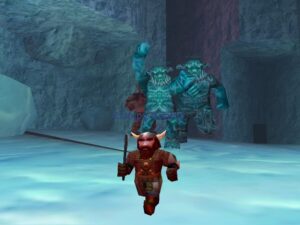
While the team was coalescing, they had the priceless opportunity to observe the successes and tribulations of their rival virtual world from Origin Systems, which, true to the iterative approach to game development, was conducting a series of small-scale public testing rounds. A watershed was reached in June of 1997, when Ultima Online conducted a two-month beta test, its biggest one ever and the last one before the game’s official release. Needless to say, everyone on the EverQuest team watched the proceedings closely. What caught all of the interested observers by surprise — not least the idealists at Origin Systems — was the quantity of players who found their fun neither as noble adventurers nor as shopkeepers, tailors, tour guides, politicians, or construction foremen, but rather as mass murderers, killing their fellow players the second they let their guard down. It ought to have been a five-alarm wake-up call for Origin, being the first indubitable harbinger of a persistent problem that would pave the way for EverQuest to replace its older, better credentialed rival as the MMORPG du jour. But they refused to countenance the obvious solution of just making it programmatically impossible for one player to kill another.
After Ultima Online launched for real in September of 1997, the developers behind it continued to struggle to find a way of addressing the problem of player murder without compromising their most cherished ideals of a fundamentally player-driven online society. They encouraged their citizens to form police forces, and implemented small changes to try to help the law-and-order contingent out, such as printing the names of those player characters who had killed at least five other player characters in scarlet letters. None of it worked; instead of a badge of shame, the scarlet letters became a badge of honor for the “griefers” who lived to cause chaos and distress. In his own words, Raph Koster put his players “through a slow-drip torture of slowly tightening behavior rules, trying to save the emergence while tamping down the bad behavior. The cost was the loss of hundreds of thousands of players.” After a wildly vacillating start, Ultima Online stabilized by mid-1998 at about 90,000 active subscribers. That wasn’t nothing by any means — on the contrary, it represented about $1 million worth of revenue for Origin every single month — but it nevertheless left a huge opening for another game that would be more pragmatic, less ideological, and by extension less murderous, that would be more focused on simple fun.
Steve Clover signed up for Ultima Online and logged on as soon as he could do so. His first hour in the world was much the same as that of countless thousands of players to come, many of whom would never log in again.
I created my own sword. I crafted my own armor and all that. I put all this stuff on, I head out to do some adventuring, and all of a sudden the screen starts slowing down. I’m like, oh, this is weird. What’s going on? And about a hundred guys run on screen and [beat] me to death, right?
I said, that will not happen in our game. That absolutely will not happen.
So, in the emerging parlance of the MMORPG, EverQuest would be strictly a “PvE,” or “player versus environment,” game, rather than a “PvP” game. The most important single key to its extraordinary success was arguably this one decision to make it literally impossible to attack your fellow players. For it would give EverQuest’s world of Norrath the reputation of a friendly, welcoming place in comparison to the perpetual blood sport that was life in Ultima Online’s Britannia. Perhaps there is some political philosophy to be found in EverQuest after all: that removing the temptation to commit crime serves to make everyone a little bit nicer to each other.
In the meantime, while Ultima Online was capturing headlines, the nascent EverQuest kept a low profile. It was seldom seen in the glossy gaming magazines during 1997 and 1998; the journal-of-record Computer Gaming World published only one half-page preview in all that time. Instead EverQuest relied on a grass-roots, guerrilla-marketing effort, led by none other than Brad McQuaid. He was all over the newsgroups, websites, and chat channels populated by hardcore MUDders and disgruntled refugees from murderous Britannia. One of his colleagues estimated that he spent half his average working day evangelizing, querying, and debating on the Internet. (Because McQuaid’s working days, like those of everyone else on the team, tended to be inordinately long, this was less of a problem than it might otherwise have been.) His efforts gradually paid off. EverQuest was voted Best Online Only Game by critics who attended the annual E3 show in May of 1998, despite having had only a backroom, invitation-only presence there. The people making it believed more than ever now that there was a pent-up hunger out there for a more accessible, fun-focused alternative to Ultima Online. They believed it still more when they moved into the public beta-testing stage, and were swamped by applicants wanting to join up. The last stage of testing involved fully 25,000 players, more than had participated in Ultima Online’s final beta.
In the midst of the run-up to launch day, John Smedley was plunged into a last-minute scramble to find a new home for his brainchild. Sony Interactive had by now been rebranded 989 Studios, a punchier name reflecting its ongoing focus on sports games. Meanwhile the Sony mother ship had begun questioning the presence of this online-only computer game at a studio whose identity was single-player PlayStation games. EverQuest would not be just another ship-it-and-move-on sports title; it would require a whole infrastructure of servers and the data pipelines to feed them, along with a substantial support staff to maintain it all and generate a never-ending stream of new content for the players. Considered in this context, the name of EverQuest seemed all too apropos. What did 989 Studios know about running a forever game? And was it really worth the effort to learn when there was so much money to be made in those bread-and-butter sports games? One day, Kelly Flock called John Smedley into his office to tell him that he couldn’t continue to feed and nurture his baby. If he wanted to keep EverQuest alive, he would have to find another caregiver.
Luckily, there was another division at Sony known as Sony Online Entertainment that was trying to make a go of it as an Internet gaming portal. Through a series of corporate contortions that we need not delve into too deeply here, Smedley’s skunk works was spun off into a nominally independent company known as Verant Interactive, with Sony Online as its chief investor.
All of this was happening during the fevered final months of testing. And yet, remarkably, the folks on the front lines were scarcely aware of the crisis at all; knowing that they had more than enough to worry about already, Smedley chivalrously shielded them from the stress that was keeping him awake at night. “I don’t remember a, ‘Hey, guys, we’re getting cancelled,'” says EverQuest “World Builder” — that was his official title — Geoffrey Zatkin. “What I remember is, ‘Hey, guys, we’re spinning out to our own studio. You’re no longer going to be Sony employees. You’re going to be employees of Verant Interactive.'” The best news of all was that Smedley was finally able to give up his hated sports games and join them full-time as the head of Verant.
EverQuest went live on March 16, 1999, a day that ought to go down in history as marking the end of the early, experimental phase of graphical MMORPGs and marking their arrival as a serious commercial force in gaming. To be sure, that original EverQuest client doesn’t look much like we expect a piece of polished commercial entertainment software to look today; the 3D view, which fills barely half the screen as a sneaky way of keeping frame rates up, is surrounded by garish-looking buttons, icons, and status bars that seemed to have been plopped down more or less at random, with a scrolling MUD-like text window that’s almost as large as the world view taking pride of place in the middle of it all. But at the time, it was all very cutting edge, making the MMORPGs that had come before it look positively antiquated in comparison. A late decision to require a 3D-accelerator card to even start the client had caused much debate at Verant. Would they be giving up too many potential subscribers thereby?
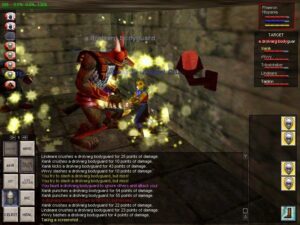
They needn’t have worried. A healthy 10,000 people signed up on the first day, and that pace was maintained for days afterward.
Like the worlds of Ultima Online and all of the early MMORPGs, EverQuest’s world of Norrath was actually many separate instances of same, each running on its own server that was capable of hosting no more than a few thousand players at one time. Verant had thought they were prepared for an onslaught of subscribers — the best of all possible problems for a new MMORPG to have — by having plenty of servers set up and ready to go. But they had failed to follow the lead of Ultima Online in one other important respect: whereas Origin Systems scattered their servers around the country, Verant ran all of theirs out of a single building in San Diego. As urban legend would have it, EverQuest consumed so much bandwidth after its launch that it disrupted Internet connections throughout the city, until more cables could be laid. This is almost certainly an exaggeration, but it is true that the pipes going directly into Verant’s offices at least were woefully inadequate. Everyone scrambled to address the emergency. John Smedley remembers “personally logging into the Cisco routers” to try to tweak a few more bytes worth of throughput out of the things: “I could actually work with the Versatile Interface Processor cards almost as well as any of our network engineers at the time.” Again, though, too many customers is always a better problem to have than the alternative, and this one was gradually solved.
Computer Gaming World didn’t publish its EverQuest review until the July 1999 issue. This was a surprisingly late date, even given the standard two-month print-magazine lead time, and it pointed to the emerging reality of the glossy magazines becoming estranged from their traditional readership, who were now getting more and more of their news and reviews online, the same place where they were doing more and more of their actual gaming. Nevertheless, Thierry Nguyen’s belated review for the magazine was a fair and cogent one, especially in the inevitable comparison with Ultima Online — and in another, less inevitable comparison that makes more sense than you might initially think.
Ultima Online is a world simulation; EverQuest is a social hack-and-slash. Ultima Online has more freedom built into it, and you can actually make a living off of trade skills. EverQuest is more about sheer adventure and combat, and the trade skills are useful, but you can’t really be a tailor or a baker.
EverQuest is the Diablo of 1999. An odd comparison, you say? Well, here’s how they’re alike: they both offer a very simple premise (“go forth and thwack many creatures to gain levels and loot”), and despite this simple premise (or maybe because of it), they’re both damn addictive and fun.
Diablo in a vastly larger, truly persistent world really isn’t a terrible way to think about EverQuest. While the folks at Origin Systems expected their players to make their own fun, to see what lay behind yonder hill for the sake of the journey, Verant gave theirs a matrix of pre-crafted quests and goals to pursue. While Ultima Online’s world of Britannia belonged to its inhabitants, EverQuest’s world of Norrath belonged to Verant; you just got to play in it. Happily for everybody, doing so could be a lot of fun. Sometimes the most delicious sort of freedom is freedom from responsibility.
By October of 1999, EverQuest had more than 150,000 subscribers, leaving Ultima Online in its dust. Raph Koster believes, probably correctly, that this trouncing of his own virtual world was driven as much by the “safety” of having no players killing other players as it was by EverQuest’s trendy 3D graphics. Ultima Online would finally relent and open safe servers of its own in 2000, but that was bolting the gate after the mounted murderers had already galloped through.
That same October of 1999, Microsoft launched Asheron’s Call, another 3D MMORPG that prevented its players from killing other players. Yet even with all of the ruthless marketing muscle and the massive server infrastructure of the biggest monopoly in technology behind it, it never came close to rivaling EverQuest in popularity. It would be a long time before any other virtual world would. By the end of 2000, EverQuest was closing in on 350,000 subscribers. The following year, it hit 400,000 subscribers. Its growth then slowed down considerably, but still it did not halt; EverQuest would peak at 550,000 subscribers in 2005.
In May of 2000, Verant Interactive’s brief-lived period of nominal independence came to an end, when the spinoff was absorbed back into Sony. Soon after, the old Sony Online Entertainment subsidiary was shut down, having failed to set the world on fire with its own simple online games based on television game shows like Wheel of Fortune and Jeopardy!, and Verant appropriated its name.
In addition to charging its subscribers a recurring fee of $10 per month, this new edition of Sony Online discovered a valuable secondary revenue stream in boxed expansion packs for EverQuest. No fewer than ten of these were released between 2000 and 2005, introducing new regions of Norrath to explore, new monsters to fight, new races and classes to fight them as, new spells to cast, and new magic items to collect, whilst also refining the graphics and interface on the client side to keep pace with competing MMORPGs. Some argued that a paying customer was reasonably entitled to expect at least some of this additional content and refinement to be delivered as part of the base subscription package. And indeed, those looking for a measure of poetic justice here were perchance not entirely deprived. There is reason to suspect that all these expansions began in time to act as a drag on the game’s growth: the need to shell out hundreds of dollars and carry home a veritable pile of boxes in order to become a fully vested citizen of Norrath was likely one of the reasons that EverQuest’s growth curve leveled off when it did. Sony Online could still profitably sell expansions to the faithful, but those same expansions made the barrier to entry higher and higher for newcomers.
Still, the fact remains that EverQuest was for six years the most popular MMORPG of them all, in defiance of a gamer culture whose appetite for novelty was notorious. There was no shortage of would-be challengers in its space; by a couple of years into the new millennium, scarcely a month went by without some new MMORPG throwing its hat into the ring. And small wonder: to publishers, the idea of a game that you could keep charging people for was tempting to say the least. Some of the newcomers survived, some even thrived for a while with subscriber counts as high as 250,000, but none came close to matching EverQuest in magnitude or longevity. A virtual world like Norrath had a peculiar stickiness about it that wasn’t a factor with other types of games. To leave EverQuest and go play somewhere else meant to leave behind a character you might have spent years building up, and, even more poignantly, to leave behind an entire circle of online friends that you had assembled over the course of that time. This was a tough pill for most people to swallow, no matter how enticing Arthurian Britain, the galaxy far, far away of Star Wars, or a world out of Japanese anime might sound in comparison to the fairly generic, cookie-cutter fantasy world of Norrath.
The huge numbers of subscribers led to knock-on effects that EverQuest’s developers had never anticipated. Within months of the game’s launch, enterprising players began selling in-world loot on sites like eBay; soon the most successful of these virtual auctioneers were making thousands of dollars every month. “What’s crazy? Me playing for twelve hours a day or someone paying real money for an item that doesn’t exist?” asked one member of this new entrepreneurial class who was profiled in The Los Angeles Times. “Well, we’re both crazy. God bless America.”
A journalist named R.V. Kelly 2, who had never considered himself a gamer before, tried EverQuest just to see what all the fuss was about, and got so entranced that he wound up writing a book about these emerging new virtual worlds.
This isn’t a game at all, I realized. It’s a vast, separate universe. People explore here. They converse. They transact business, form bonds of friendship, swear vows of vengeance, escape from dire circumstances, joke, fight to overcome adversity, and learn here. And it’s better than the real world because there are no physical consequences for making mistakes. You can derive the same sense of satisfaction for doing things well that you find in the real world, but you don’t suffer any pain or anguish when you fail. So, the game contains most of the good found in real life, but none of the bad.
Yet there were also dangers bound up with the allure of a virtual world where failure had no consequences — especially for those whose real lives were less than ideal. On Thanksgiving Day, 2001, a young Wisconsinite named Shawn Woolley was discovered by his mother sitting in front of his computer dead, the rifle he had used to shoot himself lying nearby. The monitor still displayed the EverQuest login screen. He had been playing the game rabidly for months, to the exclusion of everything else. He’d had no job, no studies, no friends in the real world. He’d effectively uploaded his entire existence to the world of Norrath. And this had been the result. Had his lonely isolation from the world around him come first, or had EverQuest caused him to isolate himself? Perhaps some of both. One can’t help but think of the classic addict’s answer when asked why he doesn’t give up the habit that is making his life miserable: “Because then I’d have no life at all.” It seemed that this was literally true — or became true — in the case of Shawn Woolley.
This tragedy cast numbers that Sony Online might once have been proud to trumpet in rather a different light. Not long before Woolley’s death, one Edward Castronova, an associate professor of economics at California State University, Fullerton, had conducted a detailed survey of the usage habits of EverQuest subscribers. He found that the average player spent four and a half hours in the game every day, and that 31 percent played more than 40 hours every week — i.e., more than a typical full-time job. Surely that couldn’t be healthy.
Widespread coverage of the the death of Shawn Woolley ignited a mainstream conversation about the potentially detrimental effects of online videogames in general and EverQuest in particular. A father was reported to have smothered his infant son without realizing it, so distracted was he by the world of Norrath on his computer screen. A couple was reported to have left their three-year-old behind in a hot car to die, so eager were they to get into the house and log into EverQuest. Parents said that their EverQuest-addled children behaved “as if they had demons living inside them.” Wives told of life as EverQuest widows: “I do not trust him [to be alone] with our daughter, simply because when I am here she will be crying and he will not do anything about it.”
The stories were lurid and doubtless quite often exaggerated, but the concern was valid. Unlike the debates of the 1980s and 1990s, which had principally revolved around the effects of videogame violence on the adolescent psyche and had relied largely on flawed or biased studies and anecdotal data, this one had some real substance to it. One didn’t need to be a Luddite to believe that playing a single videogame as much as — or to the exclusion of — a full-time job couldn’t possibly be good for anyone. Elizabeth Woolley, the mother of Shawn Woolley, became the face of the Everquest opposition movement. She was certainly no Luddite. On the contrary, she was a computer professional who had laughed at the hearings on videogame violence conducted by Joe Lieberman in the United States Senate and likewise dismissed the anti-game hysteria surrounding the recent Columbine school shootings that had been carried out by a pair of troubled DOOM-loving teenagers. All that notwithstanding, she saw, or believed she saw, a sinister intentionality behind this addictive game that its own most loyal players called EverSmack or EverCrack: “I know the analysis that goes into a game before they even start writing the code; everything is very intentional. And people would go, ‘Ah, that’s so funny, how addicting.’ And I’m like, no, it’s not funny at all.”
She wasn’t alone in vaguely accusing Sony Online of being less than morally unimpeachable. According to one reading, popular among old-school MUDders, the EverQuest team had co-opted many of the ideas behind MUDs whilst tossing aside the most important one of all, that of a truly empowered community of players, in favor of top-down corporate control and deliberate psychological manipulation as a means to their end of ever-increasing profits. One of the earliest academic treatments of EverQuest, by Timothy Rowlands, posits (in typically tangled academic diction) that
from the outset, EverQuest’s designers, motivated by profit, were interested in trying to harness (read co-opt, commoditize) the sociality that had made the virtual worlds of MUDs so successful. Resisting the linearity of older single-player games in which the players move their avatars through a series of predetermined levels, MMOs present a space in which the hero narrative, predicated upon the potential for climax — though present in the form of quests and the accumulation of avatar capital — is ultimately unrealizable. Because the aim is to keep subscribers playing indefinitely, even the arbitrary end points (level caps) are without closure. In Campbellian language, there can be no epiphany, no moment of apotheoses as the hero overcomes his trials…
For me, the existential hamster wheel described by Rowlands — himself a recovering EverQuest addict — smacks a bit too much of the life I lead offline, the one that comes down to, to paraphrase Roy Rogers, just one damn thing after another. Combine this with my awareness of the limitations of online socializing, and we can perhaps begin to see why I’ve never been much interested in MMORPGs as a gamer. Literary type that I am, if offered a choice between a second life on the computer and an interactive story of the kind that I can actually finish, I’ll take the story — the one with the beginning, middle, and end — every single time. I can’t help but think that I may have been lucky to be born with such a predilection.
Lest we be tempted to take all of this too far, it should be noted that EverQuest in its heyday was, however psychologically perilous it might or might not have been, a potential problem for only a vanishingly small number of people in relation to the population as a whole: by the metrics of television, movies, or even others forms of gaming, 550,000 subscribers was nothing. Nevertheless, the debates which EverQuest ignited foreshadowed other, far more broad-based ones to come in the fast-approaching epoch of social media: debates about screen time, about the grinding stress of trying to keep up with the online Joneses, about why so many people have come to see digital spaces as more attractive than real ones full of trees and skies and flowers, about whether digital relationships can or should ever replace in-person smiles, tears, and hugs. Meanwhile the accusations of sinister intent which Elizabeth Woolley and Timothy Rowlands leveled against EverQuest’s designers and administrators were, even if misplaced in this case, harbingers of games of the future that would indeed be consciously engineered not to maximize fun but to maximize engagement — a euphemism for keeping their players glued to the screen at all costs, whether they wanted to be there in their heart of hearts or not, whether it was good for them or not.

Gijsbert van der Wal’s famous 2014 photograph of Dutch teenagers ignoring a Rembrandt masterpiece in favor of staring at their phones has become for many psychologists, social theorists, and concerned ordinary folks a portrait of our current Age of Digital Addiction in a nutshell.
By the time those subjects really came to the fore, however, EverQuest would no longer be the dominant product in the MMORPG market. For in 2004, another game appeared on the scene, to do to EverQuest what the latter had done to Ultima Online half a decade earlier. Against the juggernaut known as World of Warcraft, even EverQuest would battle in vain.
Did you enjoy this article? If so, please think about pitching in to help me make many more like it. You can pledge any amount you like.

Sources: The books EverQuest by Matthew S. Smith, Video Game Worlds: Working at Play in the Culture of EverQuest by Timothy Rowlands, Synthetic Worlds: The Business and Culture of Online Games by Edward Castronova, Gamers at Work: Stories Behind the Games People Play by Morgan Ramsay, Legend of the Syndicate: A History of Online Gaming’s Premier Guild by Sean Stalzer, Postmortems: Selected Essays Volume One by Raph Koster, Massively Multiplayer Online Role-Playing Games: The People, the Addiction, and the Playing Experience by R.V. Kelly 2, and The Age of Addiction: How Bad Habits Became Big Business by David T. Courtwright. Computer Gaming World of December 1997, July 1999, and June 2000; Retro Gamer 263.
Online sources include “Better Together: Stories of EverQuest“ by David L. Craddock at ShackNews, “The Game Archaelogist: How DikuMUD Shaped Modern MMOs” by Justin Olivetti at Massively Overpowered, and “Storybricks + DikuMUD = Balance in MMORPGs” at Flatfingers’s theory blog. The truly dedicated may want to listen to aLovingRobot’s 50-plus hours (!) of video interviews with former EverQuest developers. And, although it’s quite possibly the most insufferable thing I’ve ever watched, the documentary EverCracked has some interesting content amidst the constant jump cuts and forced attempts at humor.
Where to Play It: EverQuest is not what it once was in terms of subscriber numbers, but it’s still online under the stewardship of Darkpaw Games, a sort of retirement home for aged MMORPGs.

















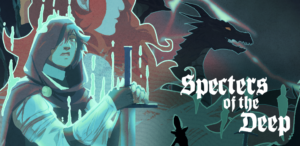

























































 From
From 












































